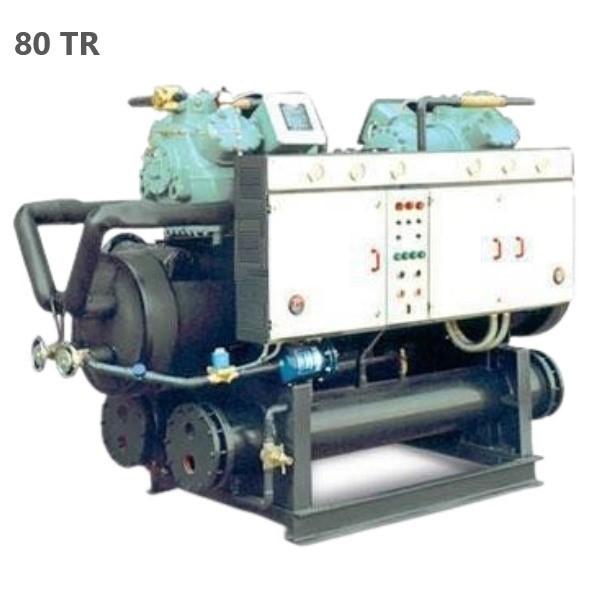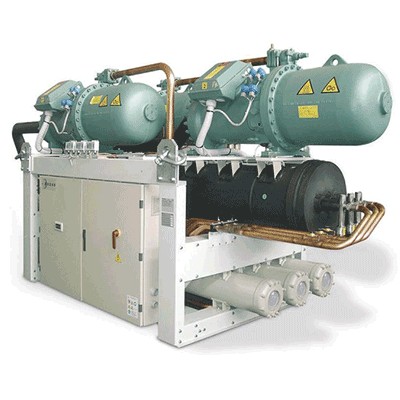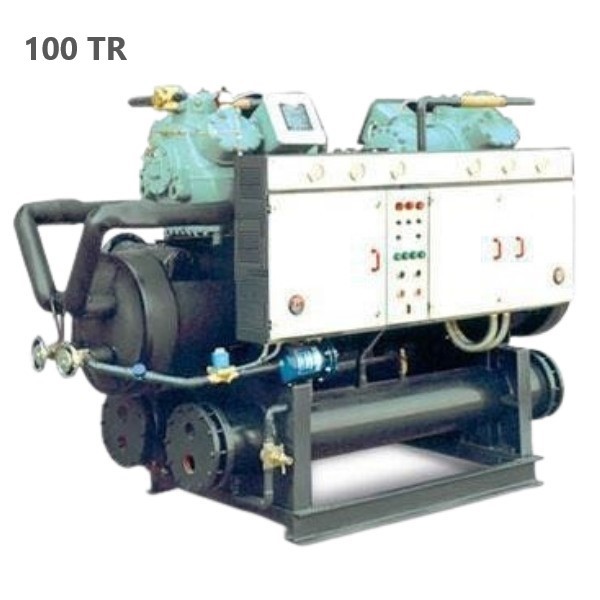Water Cooled Chiller
One of the most widely used types of equipment in centralized air conditioning systems is water-cooled chillers. Stay with us if you want to know more about water-cooled chillers' features, technical specifications, and ordering requirements.
A Technical Guide to Selecting Water-Cooled Chiller and Pricing
The water-cooled chiller is the beating heart of every building in terms of providing cold water for air conditioning and industrial refrigeration systems at a temperature of 7°C to 12°C, and its performance is based on the condensation refrigeration cycle.
In industrial facilities, water-cooled chillers provide cold water for the cooling coils of the fan coils and air handling units. In a general comparison of water-cooled to air-cooled chillers, we can say that the efficiency of water-cooled chillers is always higher than air-cooled chillers.
However, the special advantage of air-cooled chillers compared to water-cooled chillers is that there is no need for water and, as a result, no deposit in the condenser, which increases their lifespan.
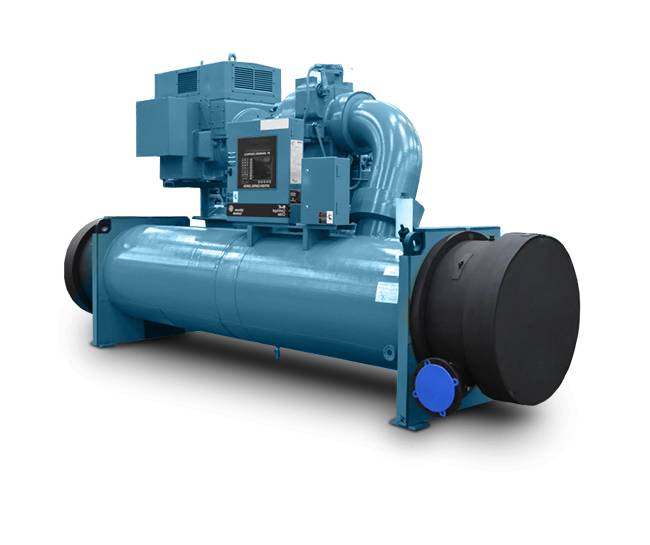
Refrigeration Cycle of the Water-Cooled Chillers
The performance of the water-cooled chiller is based on the compression refrigeration cycle. The main components of this cycle are the evaporator, compressor, condenser, and expansion valve.
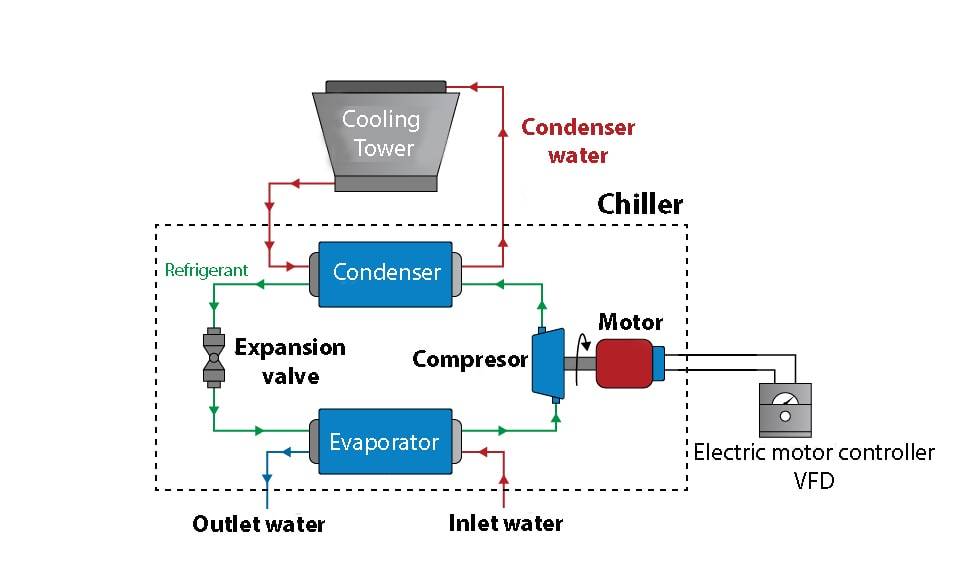
The compressor first condenses the refrigerant gas, then enters the shell of the condenser, where it gives its heat to the water of the cooling tower inside the condenser coil and then turns into refrigerant liquid.
The pressure and the speed of the refrigerant liquid are greatly reduced as it passes through the expansion valve. Then, it enters the evaporator coil immediately, resulting in a pressure drop in the evaporator, known as the heat-absorbing process.
Due to the evaporation of the refrigerant liquid into the gas inside the evaporator coil, the temperature of the water inside the evaporator shell, which is the same as the flowing water in the air conditioning system, is reduced to the desired level and completely cooled.
After that, it enters the fan coils and air handling units through the circulator pumps, and the refrigerant gas is sucked by the compressor, and this refrigeration cycle continues constantly.
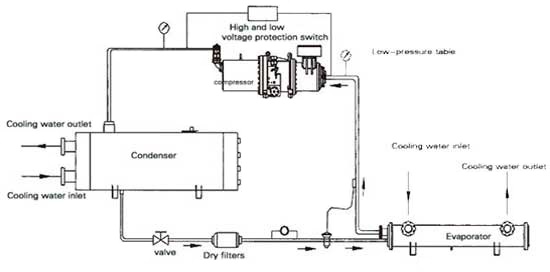
The condenser and evaporator of the compression chiller are, in fact, heat exchangers that the customer can choose (either shell and tube or plate heat exchangers).
Plate heat exchangers have many advantages, such as high speed and heat exchange levels, small volume, and more reasonable prices. However, due to the sensitivities that exist during the operation of plate heat exchangers in the matter of sedimentation on the heat exchange surfaces, water-cooled chillers are usually ordered with shell & tube condensers and evaporators.
In flooded chillers, the refrigerant gas flows inside the inner tubes of the condenser. The tower water flows inside the condenser shell to create the possibility of accurate and intelligent control of the flow rate of the working fluid (by controlling the level of the refrigerant liquid) and also to prevent deposits on the inner wall of the condenser coil.
Also, in the evaporator of flooded chillers, the air conditioning system's water flows inside the evaporator's coil tubes, and the refrigerant gas flows inside the evaporator shell.
Things to Know Before Making Any Water-cooled Chiller Purchases
When choosing water-cooled chillers, pay attention to the difference between the nominal capacity and the actual capacity of the chiller, especially concerning the maximum average outside temperature in summer in the chiller operating area.
Generally, facility experts determine the water-cooled chiller capacity required for each project by calculating the total cooling load capacity and considering various factors you should also keep in mind:
- Geographical conditions
- Ambient temperature and altitude from sea level
- Relative air humidity
- Building usage (interior temperature)
- Buildings materials
- Facade design
- Building orientation relative to the sun
- Number of floors
- The building's substructure level
- The number of occupants and electrical equipment inside the building
But suppose you want to have an approximate calculation of a chiller (phase 1 electricity) for residential and/or office buildings in climatic conditions such as Tehran, Tabriz, Isfahan, Shiraz, Mashhad, Semnan, Shahroud, Karaj, Kermanshah, Sulaimaniyah, Kirkuk, Mosul, Erbil, Aleppo, Kabul, etc. In that case, you can consider the nominal capacity of 1 ton of refrigeration (12000 BTU) for every 30 square meters of the building.
Also, before determining the final capacity and finalizing your purchase, contact the experts of DamaTajhiz HVAC Group for the correct cooling load estimation to ensure you get the right device.
Water-Cooled Chiller Advantages Compared to Air-Cooled Chillers
Water-cooled chillers have many advantages compared to air compression chillers despite the evaporation of some water in their cooling tower. The advantages are the higher coefficient of performance (COP), lower initial purchase cost, lower electricity consumption, and better service by maintenance specialists all over the Middle East.
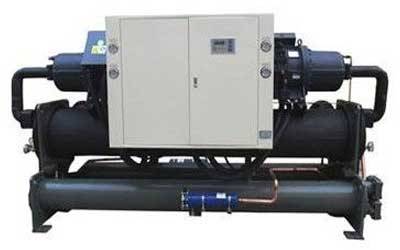
Technical Information of the Water-Cooled Chiller Circuit
Here are some of the most important information about a water-cooled chiller's circuit that we think you need to know:
- The Operation Temperature: The operating temperature of the chiller in air conditioning systems is the chilled water coming out of the chiller's evaporator, which should not be lower than 7 degrees Celsius. In addition, the temperature of the water returning to the evaporator during the system's peak load should be about 5 degrees warmer than the temperature of the water leaving the evaporator (it is also very important to note that the set temperature of the antifreeze thermostat is usually considered 4 degrees Celsius).
- Multi-Stage Thermostat: In all compression chillers, the thermostat is installed on the part of the water entering the evaporator. In contrast, in absorption chillers, due to the delay time of the system, this thermostat is usually installed on the part of the water leaving the evaporator.
Using a 3- or 4-stage thermostat based on the type of chiller, the number of compressors, the number of chiller circuits, or even the Unloader system that is installed on the part of the water exiting the evaporator can be adjusted according to the set temperatures on the gradual thermostat and control the operation of the chiller system. - The Unloader System: Installing the Unloader system in the water-cooled chiller compressor can reduce electricity consumption when reducing the refrigeration load. Capacity control, or unloader mechanism, is used to reduce the load during start-up and control the capacity during use by the required amount of cold, which increases the life of the device and its efficiency compared to other systems.
And significantly reduces the cost of energy, maintenance, and repair. Unloading the compressor in proportion to reducing the system load reduces the input power to the compressor, meanwhile reducing the stress on the engine and compressor, which is caused by turning on and off frequently. - The Flow Switch System: It is necessary to install a flow switch in the outlet water path from the condenser of the water-cooled chiller to the cooling tower to automatically turn off the chiller when the water pumps of the tower stop working. For the correct and safe operation of the water-cooled chillers, water flow in the condenser and evaporator of these chillers is necessary.
Therefore, to avoid any danger that may arise due to the lack of water flow in the condenser or evaporator of the chiller, we must place the flow switches in the circuit of the water coming out of the condenser and evaporator so that if there is no water flow in these paths, they prevent chiller water pumps, cooling tower water pumps, and chiller from starting. - The Input Water Temperature: In air conditioning systems, the water entering the cooling tower (from the condenser of water-cooled chillers) should be around 33 to 35 degrees Celsius. The water leaving the cooling tower to the condenser of water-cooled chillers (cooling water) should be around 28 to 30 degrees Celsius. In other words, the temperature difference between the inlet and outlet water of the cooling tower in air conditioning systems will be about 4 to 6 degrees Celsius.
Water-Cooled Chiller Useful Tips
Here are the most important points to keep in mind to get the most out of your water-cooler chiller:
- Superheating the refrigerant in the suction line of superheat compression chillers
- Cooling the electric motor of the compressors with the refrigerant gas flow in the suction path
- Pumping down compression chillers
- Sedimentation and acid washing of the condenser of water-cooled chillers
- The device is equipped with Low Oil Protection to prevent the compressor from operating without oil
The Main Components of a Water-Cooled Chiller
Water-cooled chillers usually have four main components: compressor, condenser, evaporator, and expansion valve. In the following, you can read the exact information about these components, their types, and how they function.
Water Cooled Chiller's Compressor
The compressor is the most important component of a water-cooled chiller, and the type, brand, and capacity you choose can largely affect the device's operation. Different types of compressors in water-cooled chillers mainly include:
- Reciprocating (piston) compressors
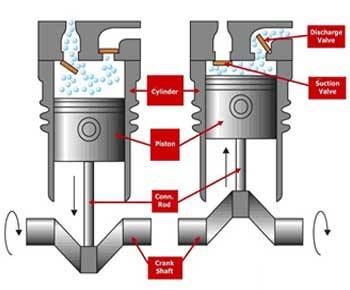
- Screw compressors
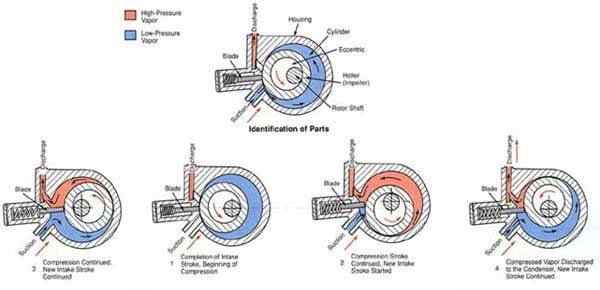
- Scroll compressors
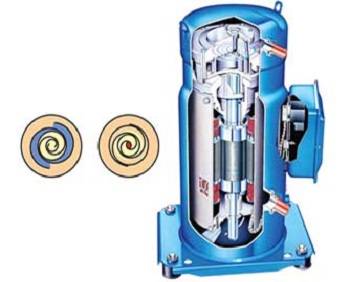
- Rotary compressors

- Centrifugal compressors
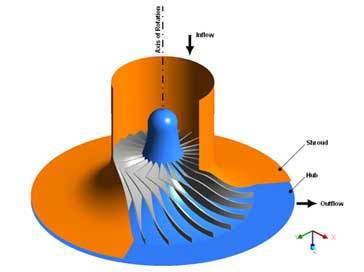
Each has advantages and merits, and paying attention to the number, capacity, type, and brand of chiller compressors is very important. The refrigerant gas mechanism also differs based on the type of compressor.
The working principles of the first four compressors (positive displacement) significantly differ from centrifugal (dynamic) compressors. In positive displacement compressors, a certain volume of gas is constantly reduced by piston, scroll, screw, or rotary function.
Moreover, as the volume of refrigerant gas decreases, the pressure increases. In centrifugal compressors, the gas is compressed due to acceleration by the rotating propeller, and the pressure increases with the decrease in speed in a diffuser. It is also mentionable that centrifugal compressors are used in very high capacities.
The Relation between the Compressor housing and the Electric Motor
As there are 3 types of relationships based on the function of the compressor, the following will provide you with the required information:
- Hermetic Compressors: In hermetic compressors, the electric motor and the compressor housing are installed in one shell, and in case of damage, the compressor or the electric motor cannot be repaired; therefore, hermetic compressors are made in small capacities.
- Semi-Hermetic Compressors: The motor and electric motor are in a two-part shell in semi-hermetic compressors. In other words, the engine and compressor parts are completely defined, the capacity of such compressors is usually average, and their capacity is more than hermetic compressors.
- Open-Type Compressors: In open compressors, the compressor housing and the electric motor are separate from each other and connected by a coupling. These compressors, called open compressors, are made in high capacities.
DamaTajhiz HVAC Group: The best prices and brands of construction equipment
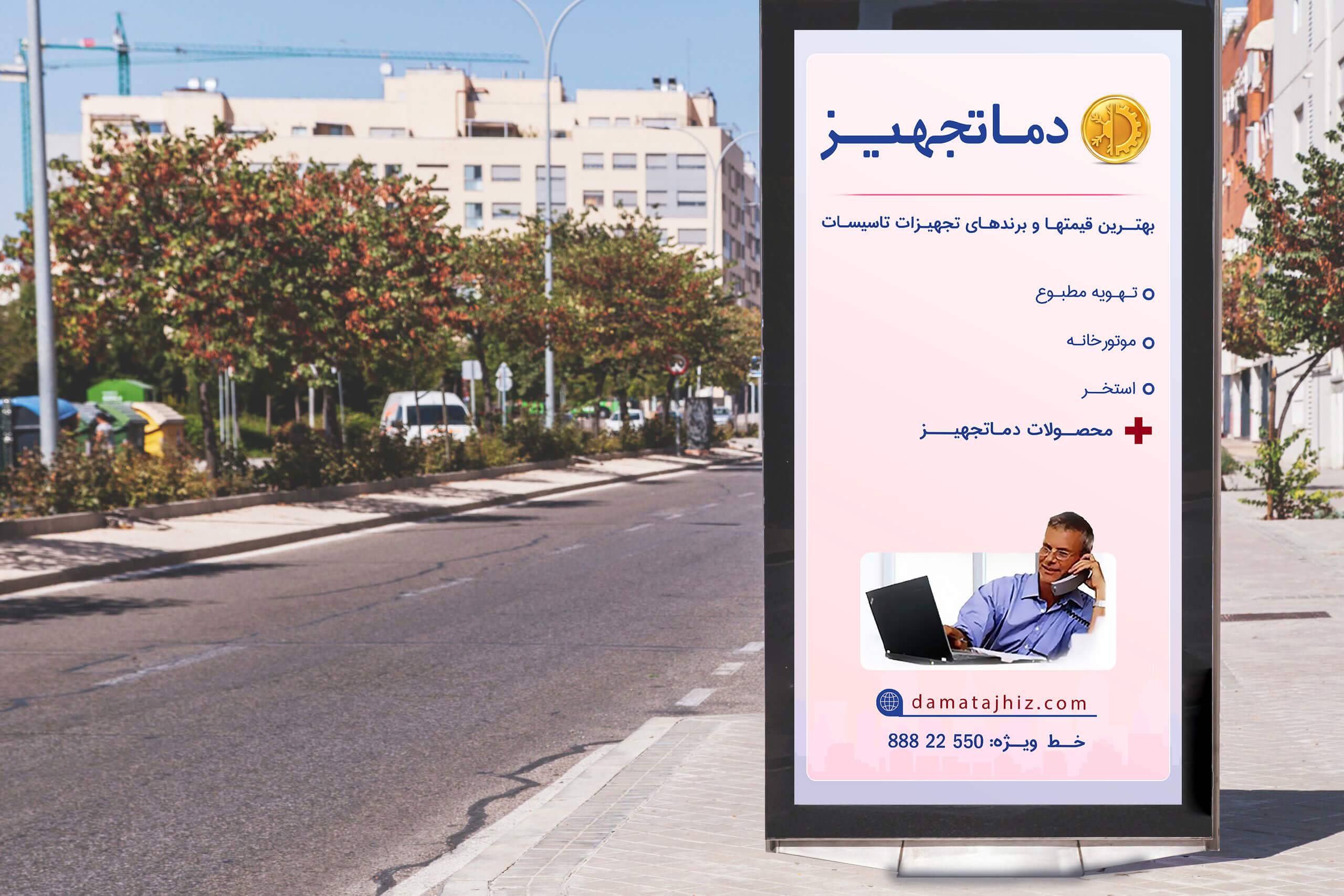
Compression Chiller's Condenser
In general, condensers in compression chillers in terms of internal structure are divided into 2 types: air-cooled and water-cooled condensers:
- Air-Cooled Condenser: In air-cooled condensers, blowing air (from the sides of the ventilation fan) and passing it over the coil's surface cools the fluid inside the coil; this condenser type consists of many finned tubes (aluminum fins).
The considered fluid (hot refrigerant gas) passes through the tubes. By forced blowing of air (from the sides of the ventilation fan) and passing it over the surface of the coil and heat exchange between the tubes and the air, it cools the hot refrigerant gas inside the tubes and finally distills it and turns it into the liquid phase. - Water-Cooled Condenser: Water is used as a cooling agent and refrigerant distillation in water-cooled condensers. In such a way that after taking the heat of the refrigerant through the cooling operation, the water is directed to the cooling tower and, after cooling down, returns to the condenser for reabsorbing heat from the refrigerant gas repeatedly; water-cooled condensers are divided into 4 categories as follows.
Comparison table of how air-cooled and water-cooled condensers work
| Air-cooled condenser | Water-cooled condenser |
|---|---|
| More power consumption | less power consumption |
| No need to water | High water consumption |
| Suitable in most climates and weather conditions | Restrictions in a few climatic conditions (hot and dry) |
| Higher initial price | Lower initial price |
| No need for water pumps | The need for cooling tower water circulation pumps |
| Lower coefficient of performance | Higher coefficient of performance (COP) |
| Installing the device outdoors | Installing the device in the central engine room |
| Simple maintenance conditions (no need for descaling) |
Complex maintenance conditions (requires descaling) |
| Larger dimensions | Smaller dimensions |
Different Types of Compression Chiller's Condenser
There are four types of condensers in terms of construction, and you can read the exact estimation of each one in the following:
- Shell & Tube Condensers: With parallel horizontal tubes embedded in a steel shell. The cooling tower's water passes through the tubes, and the refrigerant gas is placed inside the shell after the heat transfer between the water and the refrigerant gas. Gradually, the hot refrigerant gas changes phase to the liquid state.
The advantages of these condensers are the simplicity of their structure, very high strength, and the ability to withstand high pressure, as well as a reasonable price. - Plate Condenser: Plate condensers are made up of several metal plates that are placed together so that they are completely sealed against each other. The performance of these condensers is such that a cold fluid (water) and a hot fluid (refrigerant gas) flow in the spaces between the plates, and the refrigerant gas turns into the liquid with the heat exchange between these plates.
These condensers have a higher heat capacity due to the greater heat transfer surface; plate condensers are used in special applications and conditions. - Shell & Spiral Coil Condenser: In terms of performance, this type of condenser is very similar to the tube shell type, with the difference that instead of parallel horizontal tubes, a spiral coil is used in it. This type of condenser is used in low capacities.
- Double-Tube Condenser: Double-tube condensers consist of a tube with a smaller diameter placed inside a tube with a larger diameter so that the water fluid flows inside the tube with a smaller diameter, and the hot fluid flows in the space between the two tubes. This type of condenser is also used in low capacities and special applications.

Compression Chiller's Evaporator
An evaporator is a heat exchanger that transfers heat from water to refrigerant. The function of the evaporator in compression chillers is that it absorbs the heat of the water inside the evaporator after the refrigerant liquid passes through the expansion valve, and this cooled water enters the fan coils or air handling units of the project to provide cooling for the building. Evaporators are divided into 3 categories in terms of construction:
- Shell & Tube Evaporator: A group of parallel horizontal tubes is embedded in a very strong steel shell in this type of evaporator. Usually, the tubes contain liquid fluid (refrigerant), and the water circulating in the air conditioning system or industrial cycle moves around the tube (inside the shell). With the heat exchange between the liquid fluid inside the tubes and the water inside the shell, the water temperature decreases and cools down, and on the other hand, the liquid fluid changes its phase and turns into a gas by absorbing heat from the water.
- Plate Evaporator: This type of evaporator consists of metal plates placed together, and two fluids without physical contact pass through the space created between these plates that are completely sealed to each other and exchange heat. These evaporators are used in special applications and conditions.
- Finned Evaporator or DX: In this type of evaporator, the refrigerant passes through winding tubes, and the fan flows the air all around the tubes; that explains why it is sometimes called a fan evaporator; the fluid inside the tube cools the volume of air by taking heat from the air passing through the tubes and directs it to the desired location.

Water-Cooled Chiller's Expansion Valve
The expansion valve causes a sudden drop in the pressure of the refrigerant in its path to the evaporator, causing a decrease in its temperature and increasing its readiness to absorb heat in the evaporator.
Based on their design, expansion valves can be mechanical, thermostatic, or electronic. The electronic expansion valve is used in high capacities to manage and control the capacity more precisely in chillers.
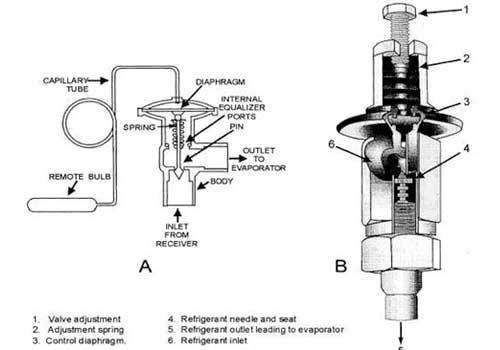
Water-Cooled Chiller's Additional Equipment
To complete the performance of the air conditioning systems and exploit its performance, other pieces of equipment are used. The most important ones are mentioned in the following:
- The Pump: Water circulation from the chiller's evaporator to the fan coil or air handling unit and from the condenser to the cooling tower (in water condensers).
- The Cooling Tower: It is used in chillers with water-cooled condensers to cool the water of the condenser.
- The Fan Coil or the Air Handling Units: The cold water produced in the system is passed through the coil of the air handling unit or fan coil to cool the air, and the air passes crosswise over the cold water coil to cool down the desired environment.
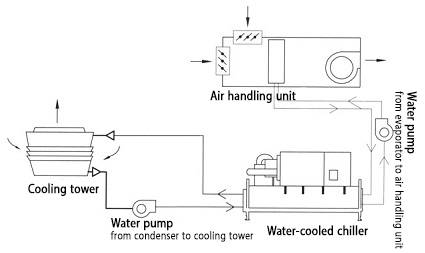
The Price of Water-Cooled Chillers
Various factors affect the price of a water-cooled chiller; the most important ones are type of the chiller (air-cooled, water-cooled, or absorption), capacity, technical specifications, and brand.
In addition, the cost of chiller installation varies based on the chiller's capacity, conditions, and the expert's salary.
Buying a Water-Cooled Chiller
Before finalizing your order, pay attention to the dimensions of the water-cooled chiller and how you will transport and install it in the engine room. It is necessary to consider sufficient lateral and longitudinal distances for the annual services of the condenser, evaporator, and compressor. As well as the repairs of other device parts at the place of installation.
Compliance with these intervals is one of the important parameters in the possibility of installing and performing periodic services and maintenance of chillers during their years of operation.
Dimensional Recommendations to Keep in Mind When Buying a Water-Cooled Chiller
Also, before ordering and buying the required chiller, pay enough attention to its dimensions and how to carry and install the chiller in the engine room. It is necessary to take into account sufficient lateral and longitudinal distances for the annual services of the condenser, evaporator, and compressor of the chiller, as well as possible repairs of other parts of the device at the place of installation of the chilled water chiller. Compliance with these intervals is one of the important parameters in the possibility of installing and performing periodic services and maintenance of chillers during their years of operation.
Water-Cooled Chiller's Pre-Order, Purchase, and Guarantee
On the DamaTajhiz HVAC website, information on dozens of types of water-cooled chillers from different brands with manufacturer guarantees has been presented for you to experience an excellent purchase.
Today, we proudly announce that DamaTajhiz HVAC Group provides all kinds of water-cooled chillers in the Middle East region, so if you need a chiller or any other product from this website, feel free to place your order. For more information, do not hesitate to contact DamaTajhiz HVAC sales experts.
Order from you, follow up from us.
1Ton of Ref.=12000 B.T.U. = 3.516 Kw
1Gal. (am.)= 3.785 Lit
1K.Cal = 4 B.T.U
C = 1.8 ˚F
˚F= 9/5 ˚C + 32
Kw X 860 = K.Cal
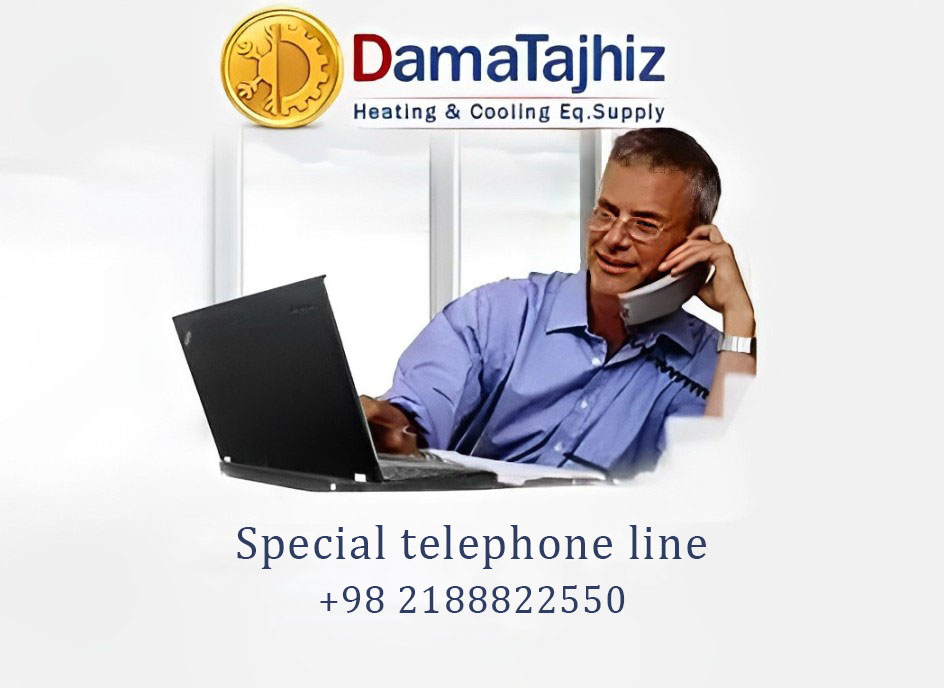
| |
Head Office: No. 463,Talebian Alley,Taleghani St.Tehran,Iran


DamaTajhiz has provided the opportunity to sell and ship specialized HVAC equipment for applicants in the following countries as the first and the most popular online store for selling HVAC equipment (Heating , Ventilation , Cooling , Air conditioning) in the Middle East : Afghanistan – Tajikistan - Uzbekistan – Turkmenistan – Azerbaijan – Armenia – Georgia – Turkey – Iraq – Syria – Jordan – Kuwait – Emirates – Qatar – Oman.




